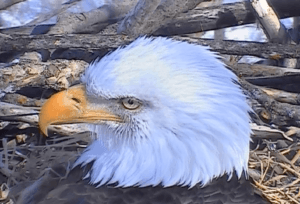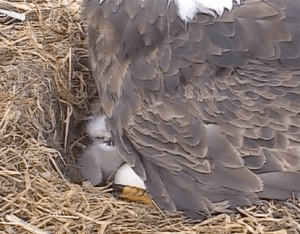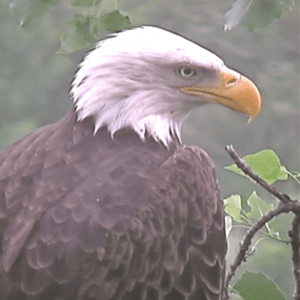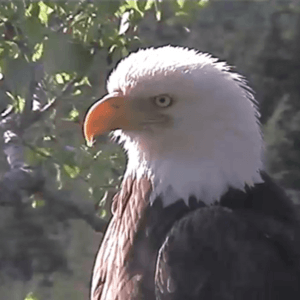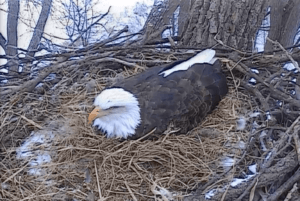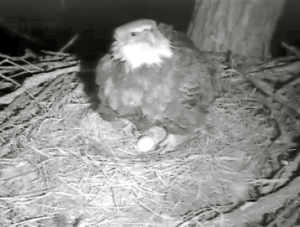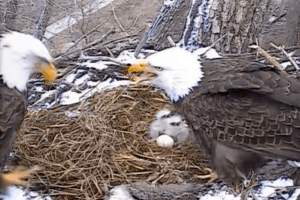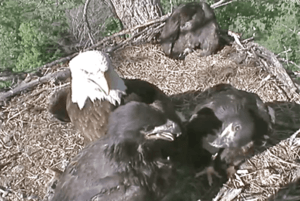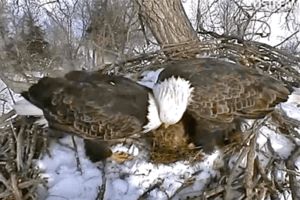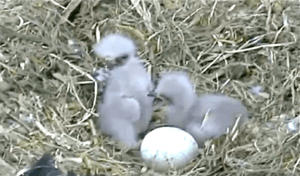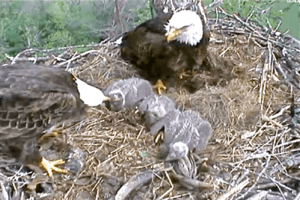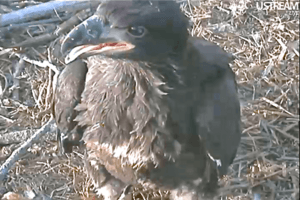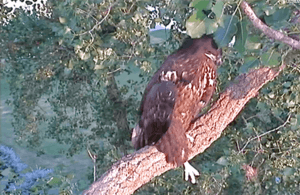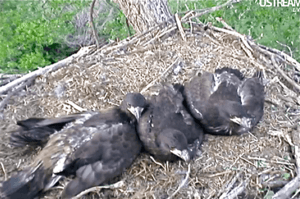Decorah Bald Eagles facts for kids
The Decorah Bald Eagles website shows a live video of a bald eagle family in Decorah, Iowa. The Raptor Resource Project set up and runs this live stream for research. It is one of many eagle webcams across the United States.
You can watch the eagle parents bring food, feed their babies, and protect them from bad weather or other animals. Special infrared lights let you see the nest all day and night during nesting season. This usually starts in January or February, and the young eagles learn to fly by June.
The Decorah Eagles became super famous online. In 2011, their website had 250 million views on Ustream, with about 2.4 million views every day! Ustream started hosting the video in 2011, but the camera was first set up in 2007. The footage was even used in a PBS show called Nature in 2008. In May 2020, the eagles were also shown in the NOVA documentary "Eagle Power."
Viewers missed the 2013 nesting season. This happened because the eagle parents built a new nest, called "N2," and moved there. Cameras were then set up at the new nest. This allowed viewers to watch the eagles again in 2014 and 2015 when the couple used N2 again.
Contents
About the Decorah Eagles Webcam
Why We Watch
The live webcam was started in 2007 by the Raptor Resource Project. It was updated in 2011 to stream live video. The Decorah Eagles' channel shows the bald eagle family in real time. You can watch them build and fix their nests, lay eggs, and care for their young. They also deal with bad weather and other animals.
The parent eagles take turns keeping the eggs warm. Over 280 million people have watched this eagle family grow. They see everything from eggs hatching to young birds learning to fly.
Eagle Family Life
PBS's Nature series released a documentary about this eagle family in 2008. It was called American Eagle. The show shared the story of the male eagle's first mate, who disappeared in a snowstorm. It also showed how he met "Mom," his mate since 2007, and how they built their nest and started a family.
Meeting the Eagles
You can learn more or watch the eagles live at raptorresource.org.
The Decorah Eagles are not given human names. This helps people remember they are wild animals, not pets. The Raptor Resource Project uses a special naming system. This helps them study the eagles without treating them like people.
How They Are Named
In 2011, the baby eagles were simply called E1, E2, and E3. After that, a new system was created to track all the babies. Now, eaglets are named with a "D" (for Decorah) and a number. This number shows the order they were born in. For example, the 2012 babies were called D12, D13, and D14.
The parent eagles were known as "Mom" and "Dad." Adult bald eagles get their white head and tail feathers when they are about 4 to 5 years old. The word "bald" in their name comes from an old word meaning "white-headed."
Mom and Dad Eagles
The Decorah Mom eagle was younger than Dad. You could tell her apart by her "eyeshadow" and some darker feathers on her head and tail. Dad had a completely white head and tail. He was also smaller than Mom, which is normal for male bald eagles. Males are usually about 25% smaller than females.
Dad Decorah disappeared on April 18, 2018, after big snowstorms. Mom Decorah raised her three babies by herself. She also met other male eagles that spring and summer. She chose a male eagle named DM2 (Decorah Male 2) as her new mate. Mom Decorah and DM2 raised eaglets in the 2018-2019 season and DM2 returned for the 2019-2020 season.
Their Homes (Nests)
The eagle couple uses three different nests. These nests are in cottonwood trees. The trees are about 400 feet apart and look over a fresh stream next to a trout farm. The first nest (N1) was used from 2007 to 2012. It was about 6.5 feet wide.
The New Nests (N2 and N2B)
In the fall of 2012, the Decorah parents built a new nest, called "N2." It was 400 feet away from N1. About 45% of bald eagle couples build more than one nest, but this was new for the Decorah pair. The Raptor Resource Project waited until the 2013 babies had learned to fly before putting cameras at the new nest. So, there was no filming in 2013. N2 got new cameras, microphones, and cables. This included a camera that could zoom and move, and a special infrared camera for night viewing. This cost over $17,000. The eagles chose N2 for their home in 2014 and 2015.
On July 18, 2015, a storm destroyed the N2 nest tree. Luckily, the young eagles had already learned to fly for the year. The Raptor Resource Project decided to try building a new nest nearby, called N2B. The eagles adopted this new nest and have been using it since 2015.
Tracking Young Eagles
To help study bald eagles, a small satellite tracker was put on one young eagle from the 2011 group and one from the 2012 group. Bob Anderson, from the Raptor Resource Project, said some fans were worried about the trackers at first. But when they saw how D1 traveled and was not harmed, they agreed it was helpful.
Anderson explained why they track the eagles: "The parents don't migrate. They stay here all year. But do the babies migrate? We don't know. We're going to find out... We're actually going to learn a little bit of science here and we're excited about that... with GPS coordinates we'll learn where these babies roam until they reach adulthood and eventually establish their own nest site."
After the young birds had been flying for a few weeks, experts helped put the trackers on them. The tracker is like a lightweight backpack and is powered by the sun. A satellite in space "pings" the tracker many times a day. This gives researchers the eagle's exact location within a few hundred feet.
D1's Amazing Journey
The Raptor Resource Project has a map that shows where D1, a female eagle born in 2011, travels. D1 was the tenth baby born to the Decorah couple, but she was named before the new numbering system.
D1 amazed researchers with how much she loved rivers and how far she could fly. She visited at least a dozen different rivers. She was expected to stay near Iowa or Illinois, but instead, she flew 1,000 miles to northern Wisconsin and Minnesota. Then she came back to Decorah in January 2012. She even flew 140 miles in just one day! D1 flew to an area "closer to Greenland than to Iowa," Anderson said. After returning to Decorah, D1 then headed to Polar Bear Provincial Park, about 1,000 miles north of Iowa, near Hudson Bay in Ontario, Canada.
In December 2012, D1 returned to Decorah for the second time. She had spent the summer above the Arctic Circle. Bob Anderson was able to track and photograph her. He said she flew away when he tried to get close. "This is good. She has a fear of people that can only help her in life." By 2014, she had flown over 2,000 miles, including two trips to Hudson Bay.
Staying Safe: A Sad Lesson
D14, from the 2012 group of babies, lived only a few months and did not travel far from Decorah. This young eagle, who had a tracker, was found at the bottom of a utility pole in late November 2012. Another sibling, D12, had a similar accident in July 2012.
A third young eagle, D18, from the 2014 group, also had a similar accident on July 8, 2014. It happened when it tried to land on a high voltage power line near Decorah. "FOUR," the last remaining young eagle from the 2014 group still in the wild, also had a similar accident on March 2, 2015. These sad events showed the danger of power poles for young eagles. After the Raptor Resource Project told the power company, crews put temporary safety covers on the poles in the area. While main power lines are usually safe for birds, older, uncovered poles can be dangerous.
The remains of these eagles were given to the Fish and Wildlife Service. This follows the Eagle feather law. Because the bald eagle is a special bird in some Native American cultures, their feathers are given to qualified Native Americans for religious ceremonies through the National Eagle Repository.
The Eagles' Popularity
In 2011, links to the Decorah Eagles website spread very quickly online. By the end of the first season, over 200 million people from 184 countries had watched. The eagles were featured in many different types of media, from tech websites to news channels.
The eagles were even mentioned on the game show Jeopardy! in May 2012. The clue was: "'In April 2011, thousands tuned in to watch these baby birds'".
Fans with binoculars even visit the Decorah Fish Hatchery. They watch the attentive parents care for their babies from a safe distance.
Bob Anderson, the head of the Raptor Resource Project, talked about the webcam's popularity on NPR. He said: "This is a positive....everybody, when they log on they go 'wow'. It's just good to have something positive to watch with so much bad news in the world."
The Decorah Newspapers wrote: "The bald eagle reality show revealed survival in the harshest weather, love and nurturing from the devoted parents, pecking order squabbles soon forgotten as sibling bonds were forged and multiple lessons in trust, patience and perseverance as the little bandit-masked, bobble-headed hatchlings evolved into beautiful juvenile raptors with distinct personalities and all the skill sets needed to venture out into the wild on their own."
Wired Science also followed the Decorah Eagles' story closely. One article about the eagles became their most popular post in 2011. Wired called the eagle cam 2011's "runaway Internet sensation." They noted that it created its own "online community of eaglophiles." According to Wired, "so many people tuned in, the traffic crashed Wired.com more than once."
Forbes magazine said that "this no-frills nature video has drawn crazy traffic of the sort that would make Justin Beiber [sic] and Beyonce jealous."
TechCrunch TV called the Decorah Eagles the web's "biggest reality TV stars" in 2011. They explained why the eagles were so popular online: "Part of what made the Decorah Eagles feed so popular was that it was so bare bones, just a profile page, and a live stream of a family of eagles doing what they do. But, with the rise of user generated content distribution media (and their popularity), social tools have the power to make the content much more engaging and interactive for viewers."
They added: "The feed didn’t include any bells and whistles to reach a broad audience, but Ustream has added a few features this year to improve upon the Decorah Eagles sitcom experience, including, for starters, night vision, high definition, and panning cameras. The company is also incorporating a "Social Stream" feature, where fans can communicate in a realtime, using an interactive chat module to share their thoughts and cheer on the eagles, as the video streams. (This also includes Facebook and Twitter integration.)"
Jon Orlin, head of TechCrunch TV, is a big fan. About the Decorah Eagles' Ustream channel, he said: "It’s pretty amazing how this live eagle channel has taken off. There are no (human) actors, writers, or fancy production or graphics. Just mother nature. Actually, it does take some impressive bird cameras and technology infrastructure. Much of the time, there isn’t a lot of action happening. But it's live, compelling, and you don’t want to miss what happens next. If it weren’t available live, it just wouldn’t have the same impact, or, likely the sizable viewership."
Fundraising Efforts
The Raptor Resource Project works with artists to raise money for the eagle webcam. They sell photography and books about the eagles. They also sell clothes, mouse-pads, mugs, and other artwork.


